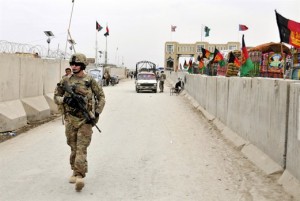The U.S. government’s military spending excess — when compared with the rest of the world — is down somewhat due mostly to troop withdrawals from Iraq and Afghanistan but still accounts for 39 percent of the global total, according to a new international study, examined by Lawrence S. Wittner.
By Lawrence S. Wittner
According to a report just released by the Stockholm International Peace Research Institute (SIPRI), world military expenditures in 2012 totaled $1.75 trillion. And, the report revealed that, as in all recent decades, the world’s biggest military spender by far was the U.S. government, whose expenditures for war and preparations for war amounted to $682 billion — 39 percent of the global total.
The United States spent more than four times as much on the military as China (the number two big spender) and more than seven times as much as Russia (which ranked third). Although the military expenditures of the United States dipped a bit in 2012, largely thanks to the withdrawal of U.S. troops from Afghanistan, they remained 69 percent higher than in 2001.

A U.S. Army lieutenant patrols a new customs yard under construction near the Afghanistan-Pakistan border in the Spin Boldak district of Afghanistan’s Kandahar province, April 8, 2013. (U.S. Army photo by Staff Sgt. Shane Hamann)
U.S. military supremacy is even more evident when the U.S. military alliance system is brought into the picture, for the United States and its allies accounted for the vast bulk of world military spending in 2012. NATO members, including the United States, spent $1 trillion dollars on the military.
Thus, although studies have found that the United States ranks 17th among nations in education, 26th in infant mortality, and 37th in life expectancy and overall health, there is no doubt that it ranks first when it comes to war.
This Number 1 status might not carry much weight among Americans scavenging for food in garbage dumpsters, among Americans unable to afford medical care, or among Americans shivering in poorly heated homes. Even many Americans in the more comfortable middle class might be more concerned with how they are going to afford the skyrocketing costs of a college education, how they can get by with fewer teachers, firefighters and police in their communities, and how their hospitals, parks, roads, bridges and other public facilities can be maintained.
Of course, there is a direct connection between the massive level of U.S. military spending and belt-tightening austerity at home: most federal discretionary spending goes for war.
The Lockheed Martin Corp.’s new F-35 joint strike fighter plane provides a good example of the U.S. government’s warped priorities. It is estimated that this military weapons system will cost the U.S. government $1.5 trillion by the time of its completion. Does this Cold War-style warplane, designed for fighting enemies the U.S. government no longer faces, represent a good investment for Americans?
After 12 years of production, costing $396 billion, the F-35 has exhibited numerous design and engineering flaws, has been grounded twice, and has never been flown in combat. Given the immense military advantage the United States already has over all other nations in the world, is this most expensive weapons system in world history really necessary? And aren’t there other, better things that Americans could be doing with their money?
Of course, the same is true for other countries. Is there really any justification for the nations of Asia, Africa, the Middle East and Latin America to be increasing their level of military spending — as they did in 2012 — while millions of their people live in dire poverty? Projections indicate that, by 2015, about a billion people around the world will be living on an income of about $1.25 per day. When, in desperation, they riot for bread, will the government officials of these nations, echoing Marie Antoinette, suggest that they eat the new warplanes and missiles?
President Dwight Eisenhower put it well in an address before the American Society of Newspaper Editors 60 years ago: “Every gun that is made, every warship launched, every rocket fired signifies in the final sense a theft from those who hunger and are not fed, those who are cold and are not clothed. . . . This world in arms is not spending money alone; it is spending the sweat of its laborers, the genius of its scientists, the hopes of its children. . . . This is not a way of life at all in any true sense. Under the clouds of threatening war, it is humanity hanging from a cross of iron.”
That sentiment persists. On April 15, people in 43 countries participated in a Global Day of Action on Military Spending, designed to call attention to the squandering of the world’s resources on war. Among these countries was the United States, where polls show that 58 percent of Americans favor major reductions in U.S. military spending. How long will it take the governments of the United States and of other nations to catch up with them?
Dr. Lawrence Wittner (http://lawrenceswittner.com) is Professor of History emeritus at SUNY/Albany and writes for PeaceVoice. His latest book is “Working for Peace and Justice: Memoirs of an Activist Intellectual.”

Who benefits financially from our continuous state of war? The world banks? The Fed? The defense contractors? Dwight D. Eisenhower was correct when he told us to beware of the Military-Industrial Complex. The LOVE of money is the root of ALL KINDS of EVIL.